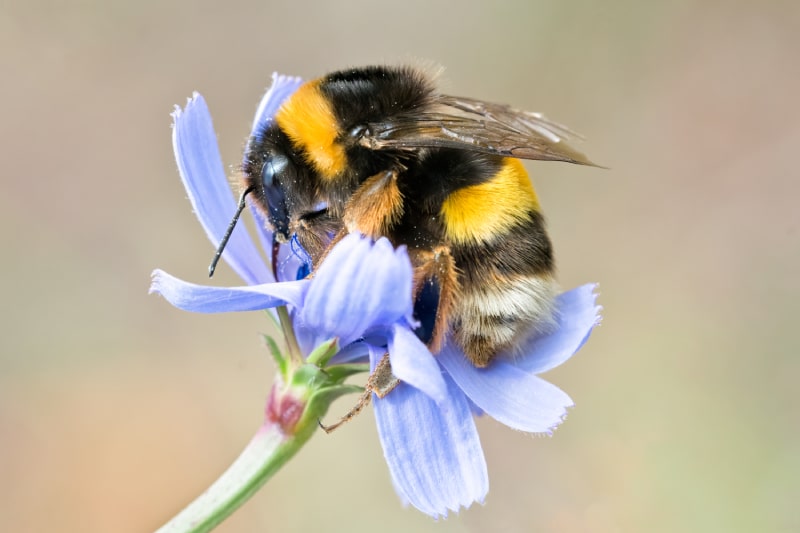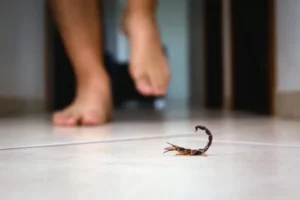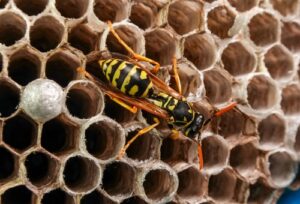Home / Blog / Bees / Bumblebees vs. Honeybees: Which Are On Your Property?
Bumblebees vs. Honeybees: Which Are On Your Property?

Scientifically reviewed by Daniel Baldwin, BCE, CCFS, CP-FS
-Published on May 3, 2023
-Updated on July 13, 2023
Honeybees and bumblebees are social insects that benefit the ecosystem. These two common bee species are expert pollinators of food crops and flowering plants. But when bumblebees or honeybees create nests inside or around your property, they pose a potential threat to you and your family. Learn more about how these two types of bees differ from one another, where they nest, and what to do about them.
Bumblebees vs. honeybees – what’s the difference?
If bees have become a nuisance at your house, it helps to recognize the difference between a bumblebee vs. a honeybee. You can tell bumblebees from honeybees by the way their bodies look.
- Bumblebees have thick, round bodies that are 0.4 to 1.6 inches large and are covered with fuzzy hair. They are black with yellow stripes.
- Honeybees have more slender, oval-shaped bodies, with hair on the head, thorax, and abdomen. They are typically yellow with light brown bands, though some honeybees have black bodies with dark-to-light stripes.

You can also identify the two types of bees by how they fly.
- Bumblebees fly around slowly at about 7 miles per hour, especially as they move from wildflower to wildflower for pollination. They make a loud, buzzing sound as they fly about.
- Honeybees can fly as fast as 15 miles per hour or more, using quick, sweeping movements to travel.

Other differences between bumblebees and honeybees?
- Bumblebees make very little honey, while honeybees produce a lot of honey.
- Honeybees live longer than bumblebees. A honeybee queen can live for more than three years. Bumblebees die off in less than a year, including the queen.
- Honeybees don’t hibernate over the winter. Instead, they huddle together for warmth within the hive. Bumblebees sleep through the colder months, using the fat stored in their bodies to help them survive.
How to identify bumblebee and honeybee nests
Bumblebees prefer to nest below the ground or close to the ground. They’ll look for holes or cavities that are already available rather than trying to build their own homes from scratch. Bumblebee nests are usually found behind your home’s siding, in piles of firewood, under birds’ nests, or in abandoned tunnels that rats or chipmunks have made. The nests are built with materials that add insulation, such as leaves or animal fur, and can contain anywhere from 50 to 500 insects in a colony.
Honeybees nest above the ground, building their hives in tree hollows or rock crevices. In rare occurrences, honeybees have nested inside the walls of a house. This type of bee builds a honeycomb that’s made up of hexagonal cells using glandular waxes they secrete. The top honeycombs cells hold honey, the middle ones pollen stores, and the lowest cells are the homes for young bees. Honeybee hives can house thousands of bees.
Are bumblebees more aggressive than honeybees?
Although neither type of bee is typically aggressive, bumblebees are slightly more aggressive than honeybees. A bumblebee will sting a person if they feel threatened. They can use their smooth stinger to attack repeatedly, but these bees don’t usually swarm to sting in large numbers.
Honeybees can only sting you once—they die after using their barbed stinger.
Are honeybee stings worse than bumblebee stings?
If you’re stung by a honeybee, the initial sting is more painful than a bumblebee’s sting. But bumblebee stings hurt, too, though! After being stung by either species, you’ll feel some pain, swelling, itchiness, and redness at the site. People who are allergic to a honeybee or bumblebee’s venom can have an allergic response.
Do bees eat honey?
Bumblebees and honeybees both make honey and eat honey.
Bumblebees mainly eat nectar, pollen from flowers, and a form of honey they produce to get the protein and sugar they need to survive. They store the nectar they’ve gathered and mix it with an enzyme in their stomach to make and store only small amounts of honey they need for the present moment. Since bumblebees don’t live for long, they don’t store or produce as much honey as honeybees.
Do all bees make honey?
Very few types of bees make honey. In fact, only 4% or less of the more than 19,000 bee species produce honey. The honeybee, Apis mellifera, is widely used to make honey in the beekeeping industry and to pollinate crops.
What’s the difference between a honeybee and a sweat bee?
Sweat bees and honeybees can both sting if they feel threatened. They’re different in many ways, though, such as:
- Sweat bees don’t produce honey.
- Sweat bees are tiny, about the size of a fingernail, which is much smaller than a honeybee.
- Honeybees are usually brown or black with yellow bands. Sweat bees have shiny, metallic bodies ranging from black or green to bright blue or purple.
- Sweat bees leave their nests in the ground and live alone.
- When a sweat bee stings you, it doesn’t leave its stinger behind.
- Sweat bees tend to land and sit on a person’s body, increasing the risk of being stung.
- Although sweat bees feed on nectar and pollen like honeybees, they’re also attracted to the salt in humans’ sweat, where they can get some of their required minerals.
Pest control services
If you have bees, or suspect you have bees on your property, we recommend calling a professional bee removal specialist. Because they’re trained in relocating a beehive intact, they’re the best for the job. The experts at Hawx Pest Control can help you identify the type of pest buzzing around your home and give you advice on how to prevent pests from setting up shop near your home—so you can enjoy your home without worrying about flying insects.
Related Articles
Visit our blog to learn more.
→





